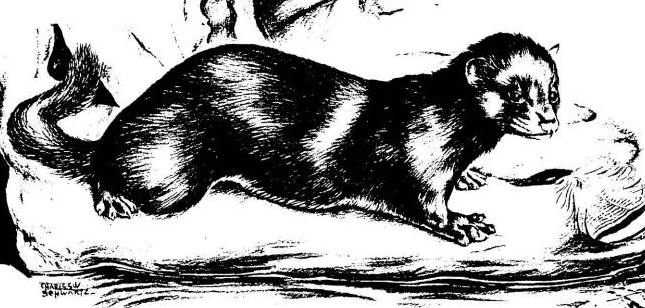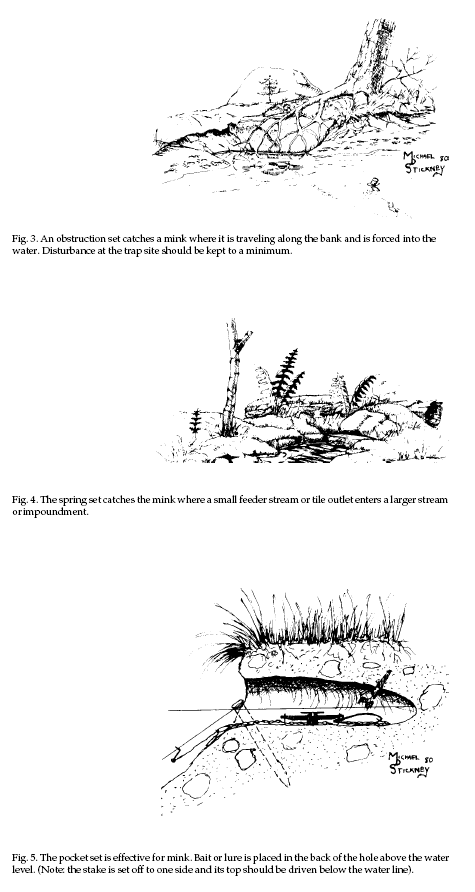|
|
|
|
 |
CARNIVORES: Mink |
|
|

Identification
The mink (Mustela vison,
Fig. 1) is a member of the weasel family. It is about 18
to 24 inches (46 to 61 cm) in length, including the
somewhat bushy 5- to 7-inch (13- to 18-cm) tail, and
weighs 1 1/2 to 3 pounds (0.7 to 1.4 kg). Females are
about three-fourths the size of males. Both sexes are a
rich chocolate-brown color, usually with a white patch
on the chest or chin and scattered white patches on the
belly. The fur is relatively short with the coat
consisting of a soft, dense underfur concealed by
glossy, lustrous guard hairs. Mink also have anal musk
glands common to the weasel family and can discharge a
disagreeable musk if frightened or disturbed. Unlike
skunks, however, they cannot forcibly spray musk.
Range and Habitat
Mink are found throughout
North America, with the exception of the desert
southwest and tundra areas (Fig. 2).
Mink are shoreline
dwellers and their one basic habitat requirement is a
suitable permanent water area. This may be a stream,
river, pond, marsh, swamp, or lake. Waters with good
populations of fish, frogs, and aquatic invertebrates
and with brushy or grassy ungrazed shorelines provide
the best mink habitat. Mink use many den sites in the
course of their travels and the availability of adequate
den sites is a very important habitat consideration.
These may be muskrat houses, bank burrows, holes,
crevices, log jams, or abandoned beaver lodges.
Food Habits
The mink is strictly
carnivorous. Because of its semiaquatic habits, it
obtains about as much food on land as in water. Mink are
opportunistic feeders with a diet that includes mice and
rats, frogs, fish, rabbits, crayfish, muskrats, insects,
birds, and eggs.
General Biology, Reproduction, and Behavior
Mink are polygamous and
males may fight ferociously for mates during the
breeding season, which occurs from late January to late
March. Gestation varies from 40 to 75 days with an
average of 51 days. Like most other members of the
weasel family, mink exhibit delayed implantation; the
embryos do not implant and begin completing their
development until approximately 30 days before birth.
The single annual litter of about 3 to 6 young is born
in late April or early May and their eyes open at about
3 weeks of age. The young are born in a den which may be
a bank burrow, a muskrat house, a hole under a log, or a
rock crevice. The mink family stays together until late
summer when the young disperse. Mink become sexually
mature at about 10 months of age.

Fig. 2. Distribution of mink in North America.
Mink are active mainly at
night and are active year-round, except for brief
intervals during periods of low temperature or heavy
snow. Then they may hole up in a den for a day or more.
Male mink have large home ranges and travel widely,
sometimes covering many miles (km) of shoreline. Females
have smaller ranges and tend to be relatively sedentary
during the breeding season.
Damage and Damage Identification
Mink may occasionally kill
domestic poultry around farms. They typically kill their
prey by biting them through the skull or neck. Closely
spaced pairs of canine tooth marks are sign of a mink
kill.
Mink will attack animals
up to the size of a chicken, duck, rabbit, or muskrat.
While eating muskrats, a mink will often make an opening
in the back or side of the neck and skin the animal by
pulling the head and body through the hole as it feeds.
Like some other members of the weasel family, mink
occasionally exhibit “surplus killing” behavior (killing
much more than they can possibly eat) when presented
with an abundance of food, such as in a poultry house
full of chickens. Mink may place many dead chickens
neatly in a pile. Mink can eat significant numbers of
upland nesting waterfowl or game bird young,
particularly in areas where nesting habitat is limited.
Legal Status
Mink are protected
furbearers in most states, with seasons established for
taking them when their fur is prime. Most states,
however, have provisions for landowners to control
furbearers which are damaging their property at anytime
of the year. Check with your state wildlife agency
before using any lethal controls.
Damage Prevention and Control Methods
Mink damage usually is
localized. If needed, lethal controls can be directed at
the individual mink causing the damage.
Exclusion
Usually the best solution
to mink predation on domestic animals is to physically
exclude their entry, sealing all openings larger than 1
inch (2.5 cm) with wood or tin and by using 1-inch
(2.5-cm) mesh poultry netting around chicken yards and
over ventilation openings. Mink do not gnaw like
rodents, but they are able to use burrows or gnawed
openings made by rats.
Habitat
Modification Habitat
modification generally is not a feasible means of
reducing mink predation problems on farms. If the
objective is to increase natural production of upland
nesting wild birds, however, habitat modification may be
applicable. The best method of increasing upland nesting
success is usually to increase the size and quality of
cover areas such as grasslands, legumes, or set-aside
areas. Although increasing the density of nesting cover
may reduce nest predation by mink, it could lead to an
increase in nest predation by species which favor dense
cover, such as the Franklin ground squirrel. Because
mink frequently use multiple den sites, elimination of
potential denning areas may reduce their densities.
Frightening
There are no known
frightening devices that are effective for deterring
mink predation.
Repellents, Toxicants,
and Fumigants
There are no repellents,
toxicants, or fumigants registered for mink damage
control.
 Trapping Trapping
Mink can most easily be
captured in leghold traps (No. 11 double long-spring or
No. 1 1/2 coilspring) or in Conibear®-type body-gripping
traps equivalent to No. 120 traps. Mink are suspicious
of new objects and are difficult to capture in live
traps. Single-door live traps may be effective if baited
and placed in dirt banks or rock walls. Double-door live
traps can be effective in runways, particularly if the
trap doors are wired open and the trap is left in place
for some time before activating the trap. Live traps may
also be effective around farmyards because mink are more
accustomed to encountering human-made objects in those
areas.
“Blind sets” are very
effective for mink if suitable locations can be found.
These sets do not require bait or lures and are placed
in areas along mink travel lanes where the animals are
forced to travel in restricted areas (Fig. 3). Good
sites for blind sets include small culverts, tiles,
narrow springs, muskrat runs, and areas under
overhanging banks or under the roots of streamside trees
(Fig. 4). If necessary, the opening can be restricted
with the use of a few sticks or grass to direct the mink
over the trap.
Another good mink set is
the “pocket set” using bait (Fig. 5). This set is made
by digging a 3-inch (7.6-cm) diameter hole horizontally
back into a bank at the water level. The bottom of the
hole should contain about 2 inches (5 cm) of water, and
it should extend back at least 10 inches (25 cm) into
the bank. Place a bait (fresh fish, muskrat carcass, or
frog) in the back of the hole above water level and
place the trap underwater at the opening of the hole.
Traps should be solidly staked and connected to a
drowning wire leading to deep water.
Fig. 3. An obstruction set
catches a mink where it is traveling along the bank and
is forced into the water. Disturbance at the trap site
should be kept to a minimum.
Fig. 4. The spring set
catches the mink where a small feeder stream or tile
outlet enters a larger stream or impoundment.
Fig. 5. The pocket set is
effective for mink. Bait or lure is placed in the back
of the hole above the water level. (Note: the stake is
set off to one side and its top should be driven below
the water line).
Use live traps around a
farmyard if there is a high likelihood of catching pets.
Otherwise, leghold or Conibear® traps can be used with
or without bait in runs or holes used by mink.
Shooting
Some states may have
restrictions on shooting mink, although many will make
exceptions in damage situations. If a mink is raiding
poultry and can be caught in the act, shooting the
animal is a quick way to solve the problem. Normally,
though, it is difficult to shoot mink because of their
nocturnal habits.
Economics of Damage and Control
Although an individual
incident of mink predation can be costly, overall the
problem is not very significant to agriculture. Mink
damage control on a case-by-case basis generally can be
justified from a cost/benefit standpoint, but
large-scale control programs are neither necessary nor
desirable. Exclusion procedures may or may not be
economically justifiable, depending on the severity of
the problem and the amount of repairs needed. Normally,
such costs can be justified for a recurring problem when
amortized over the life of the exclusion structures.
Usually damage from other predators and rodents is
reduced as well.
Mink are important
semiaquatic carnivores in wetland wildlife communities,
and are also valuable as a fur resource. About 400,000
to 700,000 wild mink are harvested each year throughout
North America, for an annual income exceeding $5
million. Therefore, all lethal control should be limited
to specific instances of documented damage.
Acknowledgments
Information for this
section came from a variety of published and unpublished
sources. Information on damage identification was
adapted from Dolbeer et al. (1994).
Figures 1 and 2 from
Schwartz and Schwartz (1981).
Figures 3, 4, and 5 by
Michael D. Stickney, from the New York Department of
Environmental Conservation publication, Trapping
Furbearers, Student Manual (1980), by R. Howard, L.
Berchielli, C. Parsons, and M. Brown. The figures are
copyrighted and are used with permission.
For Additional Information
Dolbeer, R. A., N. R. Holler, and D. W. Hawthorne. 1994.
Identification and control of wildlife damage. Pages
474-506 in T. A. Bookhout, ed. Research and management
techniques for wildlife and habitats. The Wildl. Soc.,
Bethesda, Maryland.
Eagle, T. C., and J. S.
Whitman. 1987. Mink. Pages 614-625 in M. Novak, J. A.
Baker, M. E. Obbard, and B. Mallock, eds. Wild furbearer
management and conservation in North America. Ontario
Trappers Assoc. and Ontario Ministry Nat. Resour.
Linscombe, C., N. Kinler,
and R. J. Aukrich. 1982. Mink. Pages 629-643 in J. A.
Chapman and G. A. Feldhamer, eds. Wild mammals of North
America: biology, management, and economics. The Johns
Hopkins Univ. Press, Baltimore, Maryland.
Schwartz, C. W., and E. R.
Schwartz. 1981. The wild mammals of Missouri. rev. ed.
Univ. Missouri Press, Columbia. 356 pp.
Editors
Scott E. Hygnstrom Robert
M. Timm Gary E. Larson
PREVENTION AND CONTROL OF
WILDLIFE DAMAGE — 1994
Cooperative Extension
Division Institute of Agriculture and Natural Resources
University of Nebraska -Lincoln
United States Department
of Agriculture Animal and Plant Health Inspection
Service Animal Damage Control
Great Plains Agricultural
Council Wildlife Committee
Special
thanks to:
Clemson University
|